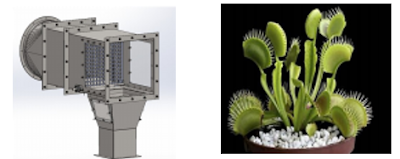Why you don't need explosion protection on drum filters
Why you don't need explosion protection on drum filters
We at ATMOS360 are in the business of engineering and manufacturing dust collection systems and equipment. As we develop the scope for new systems, as well as upgrades to existing systems, we must evaluate the options for the use of a baghouse filter versus a drum filter.
The Need for Explosion Protection
One important factor is the need for explosion protection. The cost of an explosion protection system can add as much as $100,000 to the cost of filtration equipment. The need to provide explosion protection on a baghouse filter is typically straightforward and, in most cases, is needed. Drum filters, however, are a different animal and for some installations, explosion protection is not required. Typically drum filters have rounded floors and inlet ductwork designed to provide a low sweeping inlet. This keeps the floor clean and minimizes the amount of material within the dirty air plenum.
Based on a review of NFPA 654 and discussion with NFPA resources, below is our understanding of the reasoning for why and when to provide explosion protection for drum filters.
a. Per NFPA 654 (2013) chapter 6 the person doing the risk analysis must answer the question - does an explosion hazard exist within the drum filter?
i. 6.1.7 states that an explosion hazard shall be deemed to exist in enclosed process equipment where both of the following conditions are possible:
1. Combustible dust is present in sufficient quantity to cause enclosure rupture if suspended and ignited A means of suspending the dust is present.
ii. 7.1.3 also states that a documented risk evaluation acceptable to the authority having jurisdiction is permitted to determine the level of protection to be provided.
Establishing the Dust Concentration
The key to the above is establishing sufficient quantity. MEC (minimum exposable concentration) is determined based on testing of the specific dust being handled. Some companies handling combustible dust take the position that if the quantity of dust is below 25% of MEC explosion protection is not required (NFPA 69 – 8.3.1). For most companies, however, a recommended safe level is not documented. For these situations, the process safety engineer along with all parties evaluating risk must determine the allowable operating level below MEC.
Estimating Suspended Material
Once the MEC is determined the next step is to determine/estimate the amount of material suspended in the dirty air plenum at any given time. For existing systems, this can be done by shutting down the systems and collecting and weighing the material within the enclosure. Determining dust quantity for new systems, however, is a challenge. Engineering must gather inlet dust loading information, filtration efficiencies and estimate dead space accumulations to determine the amount of material that will be in the DAP during operation. In most cases, this is a very rough estimate.
Worst Case Scenario
Another consideration is evaluating worst case scenario. During upset conditions (blinded filter media / low inlet velocities) the amount of dust in suspension within an enclosure can significantly increase. Again I refer to the risk evaluation in 7.1.3. The process safety engineer doing the risk analysis must determine the level of risk and decide if explosion protection is required. The risk evaluation would amount to reviewing the likely hood and frequency of the upset conditions occurring.
The Challenge
The challenge is that during the early phases of a project when decisions are made regarding filtration equipment (baghouse vs. drum filter) it is very hard to determine the amount of dust/material that will be suspended in the dirty air plenum of a drum filter. If there is any chance that the amount of dust would be above MEC than explosion protection should be part of options analysis for the filtration equipment. Keep in mind that besides the cost of the explosion protection components, there is also the cost associated with stiffening the filter housing to increase pressure rating. Adding explosion protection to an existing drum filter is very difficult. Unless you are close to an exterior wall you are forced to use explosion suppression. Adding stiffeners to increase MAP can also be costly. The risk of fire and explosion must be worked as part of welding on an enclosure after it is installed.
Conclusion
It is vital that the process safety community gets involved in the early phases of a project and is part of decisions regarding explosion protection for all filtration equipment. Remember, each case is different and a hazard evaluation should be part of the process when selecting filtration equipment.
AT ATMOS360 WE BELIEVE HEALTHY, SAFE BUSINESS ENVIRONMENTS IMPROVE BUSINESS RESULTS
For this and more
Contact Us Today @ http://www.atmos360.com/
#ATMOS360 #ATMOSsafe




Comments
Post a Comment